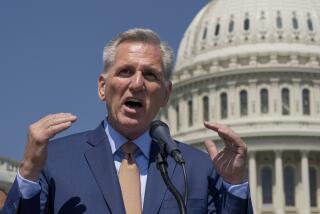Treasury Adopts New Policy to Plug Leaks
- Share via
NEW YORK — Criticized for mishandling last month’s announcement that it would stop selling 30-year bonds, the Treasury Department on Wednesday adopted new “lock-down” procedures to keep word of its moves from leaking out to markets prematurely.
Peter Fisher, undersecretary for domestic finance, also defended the Treasury against charges that it had failed to adequately prepare Wall Street for the bond decision. Critics say the government needlessly disrupted the market.
Beginning with its quarterly financing announcement on Jan. 30, 2002, Treasury said it will provide its news release a few minutes early to a handful of credentialed reporters but will sequester them until the 9 a.m. (EST) release time. The news will be released simultaneously on the Treasury’s Web site, https://www.ustreas.gov.
The new procedure is similar to those that the Federal Reserve and the Commerce and Labor departments use for disseminating market-sensitive information such as interest-rate changes and economic statistics.
The Treasury’s Oct. 31 announcement that it would cease issuance of the 30-year bond turned into a snafu when a bond-market rally began about half an hour ahead of the 10 a.m. official release time.
The announcement mistakenly was posted about 10 minutes early on the Treasury’s Web site. Also, an investment consultant who attended the news briefing telephoned several clients with the news around 9:30 a.m., although the firms that were contacted denied trading on the information.
The Securities and Exchange Commission is investigating whether anyone benefited illegally from the leaks.
That day, the 30-year T-bond posted its biggest one-day price gain since the 1987 stock market crash, as investors scrambled to snap up the securities, knowing that future supplies would shrink sharply. Many economists said the Treasury appeared to be making the move specifically to push longer-term interest rates lower, though Treasury officials have denied that.
“It was obvious the market was taken by surprise,” said Scott F. Grannis, chief economist at Western Asset Management in Pasadena. “The market had come to believe that Treasury would have jawboned it, floated the idea--anything except spring a major move like that with no notice.”
To be sure, market pros had been discussing the possible demise of the “long bond” for more than a year, as federal budget surpluses rose and the government’s need for long-term financing decreased.
However, with the deteriorating economy and the shock of the Sept. 11 terrorist attacks, projected federal surpluses suddenly became deficits, and many bond investors had assumed the government would continue to issue 30-year securities.
In the days before the Oct. 31 announcement, Fisher “thought long and hard about whether there was any way to warn the markets about this, and I didn’t come up with one,” he said Wednesday.
He rejected the idea of addressing the issue directly in a speech because it could have been even more disruptive, he said, triggering the same market reaction but “in a place where some people wouldn’t know to look for it.”
In an Oct. 23 speech, however, Fisher said the attacks and economic weakness were transient events that wouldn’t affect long-term Treasury policy. That should have been enough of a hint for anyone listening, he said.
More to Read
Inside the business of entertainment
The Wide Shot brings you news, analysis and insights on everything from streaming wars to production — and what it all means for the future.
You may occasionally receive promotional content from the Los Angeles Times.










